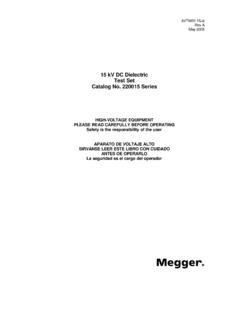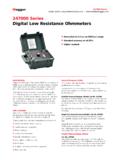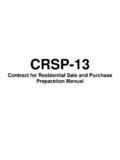Transcription of DLRO 600 High Current, Low Resistance Ohmmeter
1 MDLRO 600 High Current, Low Resistance OhmmeterUSER 11/11/08 1:27 pm Page 1 GSAFETY WARNINGSTHESE SAFETY WARNINGS MUST BE READ AND UNDERSTOOD BEFORE THE INSTRUMENT IS is supplied without a plug terminating the supply appropriate plug must be fitted prior to use. The instrument can draw 25 amps when running at full current output so please ensure an appropriateplug is DLRO600 must be grounded (earthed) when in the ground / earth in the socket outlet being used to energise the DLRO600 cannot be relied upon, the instrument must be connected to a reliableearth / ground via the large green and yellow terminal on the left hand side of the instrument. If no ground / earth is present the instrument will refuse tostart a must be de-energised before DLRO600 must only be used on dead systems. If the item under test has a voltage upon it greater than 10 volts ac peak or dc with reference toground the DLRO600 will indicate the presence of the voltage and prevent any tests being carried inductive circuits can be hazardous:The DLRO600 is a high power instrument, with an output power measured in kilowatts, designed for testing resistive loads.
2 It must NOT be used to testinductive use the DLRO600, its current leads and the sample being tested can become is normal and is caused by the passage of high currents. Take care when touching the instrument, current leads, clips and the test product is not intrinsically safe. Do not use in an explosive that the power switch is always accessible so that power can be disconnected in an this equipment is used in a manner not specified by the manufacturer, the protection provided by the equipment may be 11/11/08 1:27 pm Page 2 SYMBOLS USED IN THIS DOCUMENT AND ON THE INSTRUMENTuProtective Conductor TerminalsHot TerminalsGRefer to the User Manual for more information1 Power On0 Power OffcEquipment complies with relevant EU DirectivesCONTENTS3 SAFETY WARNINGS2 GENERAL DESCRIPTION4 OPERATION5 Main Menu Screen5 TEST Menu6 OPTIONS Menu7 CURRENT Menu9 Warning Messages9 Entering Notes In The Memo Screen9 Test Result Storage10 Real Time downloading of test TECHNIQUES & APPLICATIONS11 Test Sequence11 Lead Resistance11 Interference And Grounding The 11/11/08 1.
3 27 pm Page 3resistance from the measured value although the use of lightweight currentleads may prevent the DLRO600 from producing the full requested this case the instrument will produce the highest current possible takinginto account the Resistance of the current leads and the item being a test may be started the potential test lead contact is monitored toensure good contact is present. This reduces the chance of erroneousreadings and prevents arcing at the contact point, which would otherwisedamage the item under test and the test lead contacts. A resistancemeasurement takes approximately 7 is supplied complete with a pair of 5 metre (16 feet) current leadsterminated with large clamps, and smaller, lighter potential leads. Otherlengths and terminations are available if DLRO600 will operate with a supply voltage from 100 to 265 volts but itwill only work to full specification from 207 to 265 volts. If the input voltage isless than 207 volts it may not be possible to obtain an output of 600 the supply is at its lower limit of 100 volts, an output current of at least200 amps will be possible when using the standard leads (connected to C1and C2 terminals).
4 If the supply voltage is low, higher output currents can beobtained by using thicker or shorter current large terminals C1 and C2 supply a low voltage (from zero to 5 volts)which is adjusted automatically to produce the desired current (from 10 A to600 A). C1 is the positive terminal. This voltage is half wave rectified andunsmoothed, the inductance of the test leads providing sufficient smoothingfor the and P2 are voltage measuring terminals. P1 is nominally positive, butconnections can be reversed without affecting the measurement. All fourterminals are warning will be given if dangerous voltages are connected to any terminal(C or P) with respect to DESCRIPTION4 The Megger DLRO 600 is an powered low Resistance ohmmeterdeigned to measure resistances in the low milliohms or microhmsusing a maximum test current of 600 Amps The maximum test currentavailable is dependent upon the power supply, the Resistance of the testleads and the Resistance of the item being tested.
5 full details are availablein the SPECIFICATIONS section later in this power lead entry is located on the left-hand side panel and marked 100-265 V , 25 A max., 50/60Hz . The main On/Off switch is locatednext to the power lead entry. All other controls are mounted on the frontpanelPrinciple of operationThe required current is set before the test starts. When the TEST button ispressed, after a short delay the current increases to the set current, thevoltage detected across the "P" leads is measured, and the current thenreduces to is controlled using the two-axis paddle and the menu system,which appears on the backlit liquid crystal display. The keyboard is used toset the desired test current and to add notes, which may be stored with testresults in on board memory for later download via the RS232 socketprovided. The measured Resistance , the actual test current and measuredvoltage are clearly presented on the display after the test is use of a four terminal measurement technique removes the test 11/11/08 1:27 pm Page 4 MAIN MENU SCREENThis screen provides access to the menuing system, through which you set upyour instrument and choose the desired test parameters.
6 Navigation of thismenuing system is by means of the cursor control and Enter the top of the screen are the three main menu choices; "TEST","OPTIONS" and CURRENT".Below this are details of the test current selected (SET CURRENT), maximumcurrent to be allowed (CURRENT LIMIT), the number of stored tests and thecurrent date and perform a measurement is straightforward. 1. Use the Left and Right arrows of the two-axis cursor control to highlight the TEST menu. Use the down arrow to select the required test type. Press Use the Left and Right arrows of the two-axis cursor control to highlight the CURRENT menu. Use the down arrow to select SET and press Enter. Type in the desired current using the numeric keys on the keypad. When finished press the current you have set is greater than the current limit, DLRO600 will beep and clear the SET CURRENT field. Re-enter the desired current, if necessary increasing the current limit to a value equal to or greater than the desired level.
7 (See separate topic for setting the current limit).3. Connect the sample to be tested to the instrument terminals and press the TEST button. The different test types have slightly different connection requirements, which are detailed, in the sections note that if your DLRO600 is inadequately grounded / earthed it willOPERATION5 Terminate the supply lead with a plug suitable for your the instrument supply lead into a socket outlet and switch theinstrument on using the On/Off switch situated on the left side of theinstrument. The POWER lamp will illuminate, the instrument will displaythe firmware version number and perform a calibration check. If this issuccessful the display will show "CALIBRATED". If the check fails thedisplay will show "NOT CALIBRATED .After a slight pause the display will change to the Main Menu 600 LIMITED2002 INITIALISING HARDWARECALIBRATEDTEST OPTIONS CURRENTSET CURRENT 450 CURRENT LIMIT 500 23 TESTS STORED21/03/02 15 11/11/08 1:27 pm Page 56 OPERATIONnot be possible to start a MenuThe TEST menu allows the selection of one of three test modes - Normal,Automatic or Continuous.
8 Only one mode can be active at a time and theactive mode is displayed below the heading TEST when you return to theMAIN ModeNormal mode makes a single measurement of the Resistance of the sampleunder note that in this mode both the current and voltage leads must beconnected across the test sample before the Test button is pressed. Whenthe TEST button is pressed DLRO600 will check for good contact in the Pcircuit. If the P circuit continuity is faulty the display will show "POTENTIALFAIL". Press the ENTERkey to remove this message and adjust the contactofthe P probes to ensure good contact is achieved. Press the TEST buttonagain. P circuit continuity will be checked and if satisfactory DLRO600 willproceed to carry out a test. After a short period of time, if there is inadequatecontact in the C circuit the instrument will display "CURRENT LOOP FAIL".Press Enter to remove this message, make good the connection and pressthe TEST button to start the test.
9 A sequence of bars will appear across thedisplay while the test is being make another measurement, ensure the test leads are connected andpress the Test is abbreviated to NORM under the TEST heading in themain menu ModeContinuous mode requires the current leads and the voltage leads to besecurely connected to the item under test before pressing the Test DLRO600 checks voltage and current loop continuity as in Normal Modeand, if adequate, passes a continuous current, repeating resistancemeasurements at approximately 2-second intervals until the test is terminatedby pressing the Test button (or until the DLRO600 overheats if particularlyhigh currents are used).CONTINUOUS mode is abbreviated to CONT under the TEST heading inthe main menu operating continuously at 600 A, overheating will occur afterapproximately 3 minutes (assuming a starting temperature of 20 C). Amessage HOT will then appear on the display until the internal parts havecooled.
10 When the HOT message is on the screen, test current is turned offand all front panel controls are at reduced current will considerably extend the operating ModeIn Automatic mode, only connect the current leads to the sample to bemeasured. Press the TEST button. The red status lamp next to the TEST button will flash signifying that DLRO600 is armed and will remain in a stateof readiness until the P circuit is completed. At this time the light willilluminate continuously and the test will be carried out. The progress of thetest is shown by a series of bars progressing across the make another measurement it is necessary to break P probe contact withthe test sample and remake example, if measuring joints in a long bus bar, you may leave the currentcircuit connected at opposite ends of the bus bar knowing that current willonly flow during a measurement when the P probes are making contact with voltage probes across the joint(s) you wish tomeasure will then activate the 11/11/08 1:27 pm Page 6 OPERATION7 Downloading data does not cause the stored data to be erased frommemory.
















